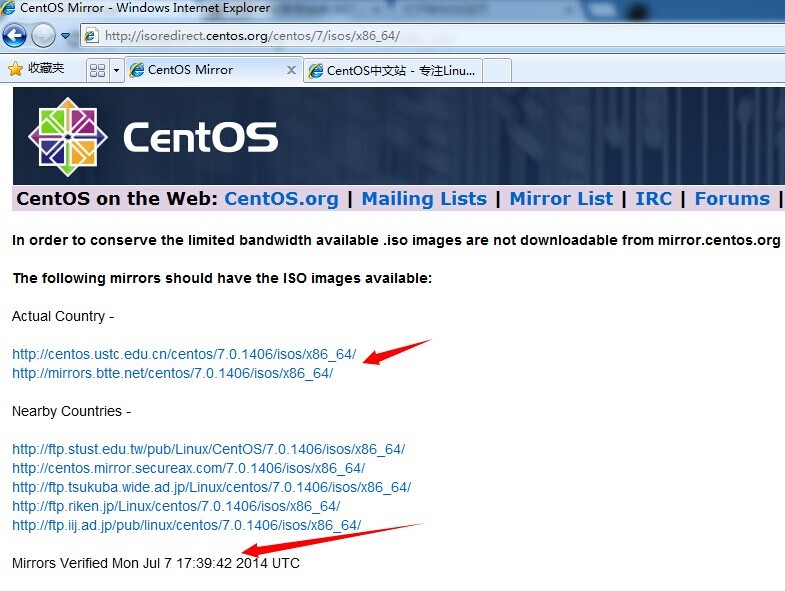CentOS 7.0.1406 official version released
At 17:39:42 on July 7, 2014, local time in the United States, CentOS officially released the CentOS7.0.140 64-bit version download address, the main update: the kernel is updated to 3.10.0, supports Linux containers, Open VMware Tools and 3D graphics can be instantly LVM snapshots of out-of-the-box, OpenJDK-7 as the default JDK, in-place upgrade from 6.5 to 7.0 (mentioned above), ext4 and XFS.

1. translation###
This release note is available in the following languages:
2. Introduction###
Welcome to the first release version of CentOS-7. CentOS is an enterprise-level Linux distribution, which is derived from the free and open source code of Red Hat1.
CentOS fully complies with Red Hat's redistribution policy and strives to be fully functionally compatible with upstream products. CentOS's modifications to components are mainly to remove Red Hat's trademarks and artwork.
We have decided not to follow Red Hat's installation alias. The system administrator can access all "channels" during installation.
For the first time, a supported upgrade path is provided from CentOS-6 to CentOS-7. This path only supports upgrading from the latest version of CentOS-6 (6.5 at the time of writing) to the latest version of CentOS-7. More information about the upgrade procedure can be found on this page. The tool that provides this feature is still being tested and will be released later. If you can assist with the test, please refer to the discussion on the CentOS-Devel mailing list.
Before you try to install or report a problem, please read the other sections.
3. Installation media###
CentOS provides different installation images. The image you need depends on your installation environment. These images can be burned on a DVD or written in a USB memory stick with dd.
If you are not sure which image is suitable, please select DVD image. It allows you to choose which components to install.
We also have live media images of Gnome and KDE desktop environments. They allow you to test CentOS by booting from a DVD or USB stick. The third livecd image uses Gnome: as the name suggests, this image is small enough to fit on a CD. The image does not contain libreoffice. You can also use live media images to install CentOS on your hard drive, but please note that what you installed is exactly what you see when using live media. If you want more flexibility in selecting components, please use DVD images.
The netinstall image is suitable for installation on the network. After booting with the netinstall image, the installer will ask where to download the installed components.
The everything image contains all the components provided by CentOS, including those that cannot be installed directly through the installer. If you want to install these packages, you must mount the installation media after completing the system installation, and then copy or install the components from there. For most users, use yum install after installing the DVD image
4. Verify the installation image after downloading###
Before copying the downloaded images to the required installation media, you should check their sha256sum first.
5. Major changes###
Like the first release of each major version, most components have been changed and updated to the newer version. Listing all changes is outside the scope of this document. The most significant changes are:
- Kernel updated to 3.10.0
- Support for Linux containers
- Open VMware Tools and 3D graphics can be installed and used immediately
- OpenJDK-7 as the default JDK
- In-place upgrade from 6.5 to 7.0 (mentioned above)
- LVM snapshots of ext4 and XFS
- Switch to systemd, firewalld and GRUB2
- XFS as the default file system
- ISCSI and FCoE in the kernel space
- Support PTPv2
- Support 40G Ethernet network card
More data has been included here or here.
6. Downgrade function###
- No, because this is the first release of CentOS-7
7. Known issues###
The list of upstream known issues is included here.
- Many users complained that the new default NetworkManager tool will not enable the Ethernet network interface and must be manually enabled during installation. See CentOS-7 FAQ #2.
- The installer requires a minimum of 406MB of RAM to run. On systems with less than 406MB, the installer will terminate abnormally. The minimum memory requirement for C7 is 512MB.
- Cannot install CentOS-7 on the encrypted file system in UEFI mode on a VirtualBox virtual machine correctly. Unless the kernel command line is modified, the system will not ask for the sector password after installation. See the bug report for details.
- If the resolution of your screen is 800x600 or lower, the bottom of the installation screen will be cut off.
8. Issues fixed
- Not in this version
9. Components and applications###
9.1. Components modified by CentOS####
9.2. Components deleted by CentOS but included in the upstream distribution
9.3. Components added by CentOS but not included in the upstream release####
10. Source code###
All CentOS-7 source codes are included in git.centos.org.
The source code RPM will also be released in the vault:
- OS: http://vault.centos.org/centos/7.0.1406/os/Source/SPackages/
- Updates: http://vault.centos.org/centos/7.0.1406/updates/Source/SPackages/
- Extras: http://vault.centos.org/centos/7.0.1406/extras/Source/SPackages/
- CentOSPlus: http://vault.centos.org/centos/7.0.1406/centosplus/Source/SPackages/
- CentOS Chinese website download address: http://www.centoscn.com/CentosSoft/iso/2014/0708/3266.html
Recommended Posts